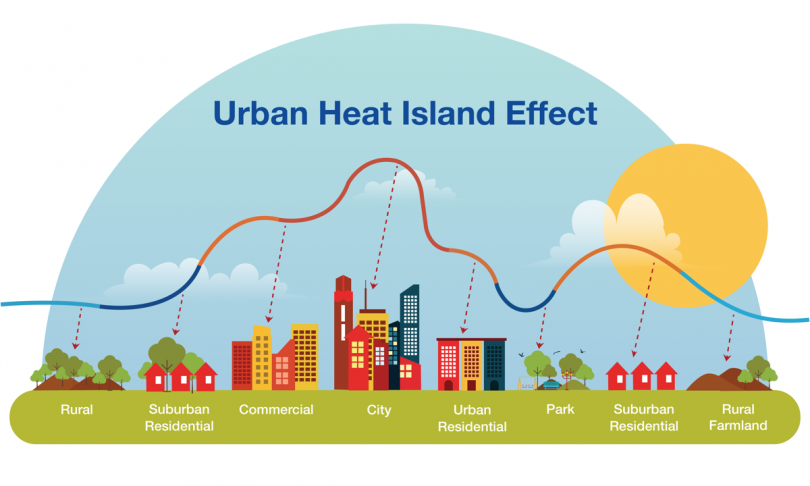Ahmedabad
(Head Office)Address : 506, 3rd EYE THREE (III), Opp. Induben Khakhrawala, Girish Cold Drink Cross Road, CG Road, Navrangpura, Ahmedabad, 380009.
Mobile : 8469231587 / 9586028957
Telephone : 079-40098991
E-mail: dics.upsc@gmail.com

Urban Heat Islands
News: Recently, several parts of India are experiencing severe heat waves. Urban areas and cities are the places which have higher temperatures than rural places. This phenomenon is referred to as 'Urban Heat Island'.
About:
• It is a phenomenon where certain pockets within a city are experiencing higher heat load than its surrounding area.
• It is temporary in nature.
• The rise of heat is basically due to buildings and houses of cities made up of concrete where the heat is trapped and not able to dissipate easily.
Causes of Urban Heat Islands:
• Increase in construction activities is the primary reason. From building simple homes to huge infrastructures, carbon absorbing materials like asphalt and concrete is needed for expansion of cities.
They trap huge amounts of heat which increases the mean surface temperature of urban areas.
• Rooftops of many buildings have dark surfaces, thereby decreasing albedo and increasing absorption of heat.
• Buildings with dark surfaces require more cooling from air conditioning, which requires more energy from power plants, which causes more pollution. Air conditioners, also exchange heat with atmospheric air, causing further local heating.
• Increasing use of vehicles and unimpeded use of fossil fuels also add warmth to urban areas.
• Lack of green cover in the cities impedes evapotranspiration, shade and removal of carbon-dioxide, all the processes that help to cool the surrounding air.
Steps to minimize impact of Urban Heat Islands:
• Increase area under Green Cover
• Passive cooling technology, a widely-used strategy to create naturally ventilated buildings, can be a vital alternative to address the urban heat island for residential and commercial buildings. The IPCC report cites ancient Indian building designs that have used this technology, which could be adapted to modern facilities in the context of global warming.
• Use of appropriate construction material, roof and terraces to be painted in white or light colours to reflect heat and reduce the absorption.
• Promoting Terrace plantation and kitchen gardening can also be a solution.
Observation of NASA’s Ecostress:
• An image acquired by NASA’s Ecosystem Spaceborne Thermal Radiometer Experiment (Ecostress), revealed a massive red spot over Delhi and smaller red patches around neighboring cities Sonipat, Panipat, Jind and Bhiwani.
• It observed higher incidences of heat island in urban parts of Delhi is occurring. Temperatures were significantly higher in urban part of Delhi than in surrounding areas.
• Ecostress is a radiomter-equipped device that was sent to the International Space Station in 2018 by NASA.
• Ecostress is primarily responsible for assessing in the temperature of plants, as well as knowing their water requirements and the influence of the climate on them.

Address : 506, 3rd EYE THREE (III), Opp. Induben Khakhrawala, Girish Cold Drink Cross Road, CG Road, Navrangpura, Ahmedabad, 380009.
Mobile : 8469231587 / 9586028957
Telephone : 079-40098991
E-mail: dics.upsc@gmail.com
Address: A-306, The Landmark, Urjanagar-1, Opp. Spicy Street, Kudasan – Por Road, Kudasan, Gandhinagar – 382421
Mobile : 9723832444 / 9723932444
E-mail: dics.gnagar@gmail.com
Address: 2nd Floor, 9 Shivali Society, L&T Circle, opp. Ratri Bazar, Karelibaugh, Vadodara, 390018
Mobile : 9725692037 / 9725692054
E-mail: dics.vadodara@gmail.com
Address: 403, Raj Victoria, Opp. Pal Walkway, Near Galaxy Circle, Pal, Surat-394510
Mobile : 8401031583 / 8401031587
E-mail: dics.surat@gmail.com
Address: 303,305 K 158 Complex Above Magson, Sindhubhavan Road Ahmedabad-380059
Mobile : 9974751177 / 8469231587
E-mail: dicssbr@gmail.com
Address: 57/17, 2nd Floor, Old Rajinder Nagar Market, Bada Bazaar Marg, Delhi-60
Mobile : 9104830862 / 9104830865
E-mail: dics.newdelhi@gmail.com